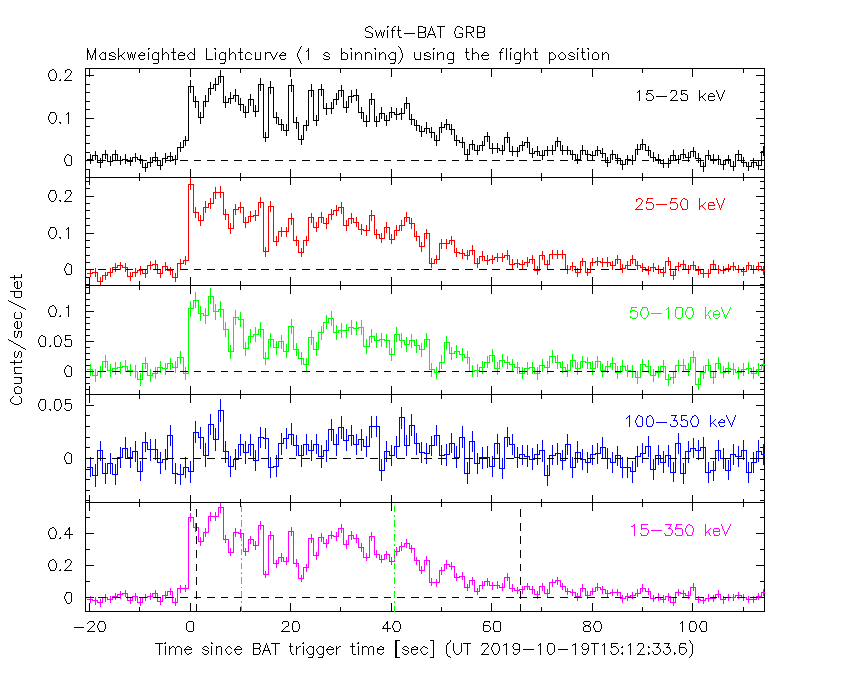
K.K. Simpson (PSU), A. D'Ai (INAF-IASFPA) and S.J. LaPorte (PSU) for the Swift team
At 15:12:33 UT, the Swift Burst Alert Telescope (BAT) triggered and located GRB 191019A (trigger=930285) (Simpson et al. GCN Circ. 26031). Swift did not slew due to an observing constraint. At the time of the trigger, the initial BAT position was 129° from the Sun (9.1 hours East) and 117° from the 70%-illuminated Moon. Table 1 contains the best reported positions from Swift, and the latest XRT position can be viewed at http://www.swift.ac.uk/xrt_positions.
LaPorte and Simpson (GCN Circ. 26053) reported the detection with UVOT of an optical afterglow. Perley et al. (GCN Circ. 26062) reported the position from NOT for the optical afterglow of this GRB. Fynbo et al. (GCN Circ. 26041) determined a redshift of 0.248 from NOT. Table 2 is a summary of GCN Circulars about this GRB from observatories other than Swift.
Standard analysis products for this burst are available at https://gcn.gsfc.nasa.gov/swift_gnd_ana.html.
As reported by Krimm et al. (GCN Circ. 26046),
the BAT ground-calculated position is RA, Dec = 340.035, -17.340 deg which is RA(J2000) = 2
The mask-weighted light curve (Figure 1) shows a complex structure with many overlapping pulses that starts at ~
The time-averaged spectrum from T-0.83 to T+84.28 s is best fit by a simple power-law model.
The power law index of the time-averaged spectrum is 2.25 ± 0.05.
The fluence in the 15-150 keV band is 1.0 ± 0.03 x 1
The results of the batgrbproduct analysis are available at https://gcn.gsfc.nasa.gov/notices_s/930285/BA/.
Analysis of the initial XRT data was reported by D'Ai et al. (GCN Circ. 26045). We have analysed 24 ks of XRT data for GRB 191019A, from 3.3 ks to 566.7 ks after the BAT trigger. The data are entirely in Photon Counting (PC) mode. The enhanced XRT position for this burst was given by Osborne et al. (GCN Circ. 26043).
The light curve (Figure 2) can be modelled with a power-law decay with a decay index of α=1.28 (+0.17, -0.15).
A spectrum formed from the PC mode data can be fitted with an absorbed power-law with a photon spectral index of 2.0 ± 0.4. The best-fitting absorption column is 9 (+12, -9) x 1
A summary of the PC-mode spectrum is thus:
Galactic foreground: 3.3 x 1
Intrinsic column: 9 (+12, -9) x 1
Photon index: 2.0 ± 0.4
The results of the XRT team automatic analysis are available at http://www.swift.ac.uk/xrt_products/00930285.
The Swift/UVOT began settled observations of the field of GRB 191019A 3294 s after the BAT trigger
(LaPorte and Simpson GCN Circ. 26053).
A fading source consistent with the XRT position (Evans et al. GCN Circ. 26034) is detected in the initial UVOT exposures.
Table 3 gives preliminary
magnitudes using the UVOT photometric system
(Breeveld et al. 2011, AIP Conf. Proc., 1358, 373).
No correction has been made for the expected extinction in the Milky Way
corresponding to a reddening of

Figure 1. The BAT
mask-weighted light curve in the four individual and total
energy bands. The units are counts

Figure 2. The XRT light curve.
Any data from a crosshatched region are not included in the fit.
| RA (J2000) | Dec (J2000) | Error | Note | Reference |
|---|---|---|---|---|
| 2 |
-17°19'41.3" | 1.7" | XRT-final | UKSSDC |
| 2 |
-17°19'40.9" | 2.4" | XRT-enhanced | Osborne et al. GCN Circ. 26043 |
| 2 |
-17°20'23.9" | 1.0' | BAT-refined | Krimm et al. GCN Circ. 26046 |
| Band | Authors | GCN Circ. | Subject | Observatory | Notes |
|---|---|---|---|---|---|
| Optical | Lipunov et al. | 26032 | MASTER optical observation | MASTER | |
| Optical | Lipunov et al. | 26033 | Swift GRB191019.63: Global MASTER-Net observations report |
MASTER | |
| Optical | Reva et al. | 26036 | TSHAO optical observations, probable afterglow and host galaxy |
Zeiss-1000 | |
| Optical | Perley et al. | 26039 | NOT optical observations | NOT | |
| Optical | Fynbo et al. | 26041 | NOT optical spectroscopy of candidate counterpart |
NOT | spectroscopy |
| Optical | Guelbenzu | 26042 | GROND observations | GROND | detection |
| Optical | Lipunov et al. | 26044 | Swift GRB191019.67: Global MASTER-Net observations report |
MASTER | |
| Optical | Zhu et al. | 26059 | Nanshan-0.6m optical observations | Xinjiang Astro. Obs. | |
| Optical | Perley et al. | 26062 | NOT optical afterglow and host association confirmation |
NOT | |
| Optical | Gendre et al. | 26098 | Zadko Telescope optical observations | Zadko | light curve |
| Filter | Exp(s) | Mag | ||
|---|---|---|---|---|
| b | 4541 | 4741 | 196 | |
| uvm2 | 5361 | 5561 | 196 | >19.20 |
| u | 4336 | 4536 | 196 | >19.43 |
| v | 5156 | 5356 | 196 | >18.75 |
| uvw1 | 4131 | 4331 | 196 | >19.13 |
| uvw2 | 4952 | 5151 | 196 | >19.28 |
| white | 4746 | 4946 | 196 | 19.66± 0.20 |
| white | 27982 | 28668 | 668 | 20.27± 0.18 |
Table 3. UVOT observations reported by LaPorte and Simpson (GCN Circ. 26053). The start and stop times of the exposures are given in seconds since the BAT trigger. The preliminary detections and 3-σ upper limits are given. No correction has been made for extinction in the Milky Way.
October 31, 2019